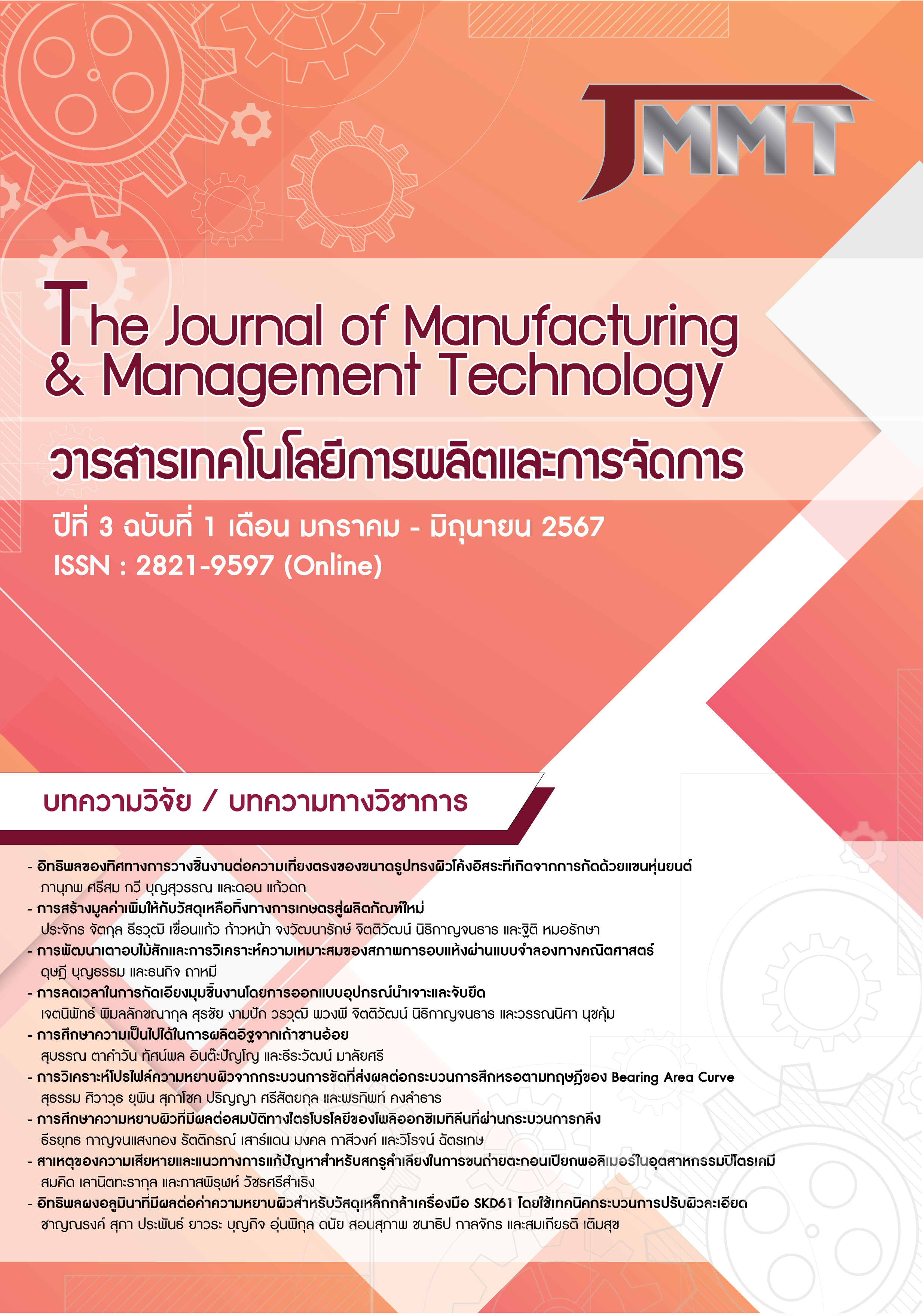การศึกษาความหยาบผิวที่มีผลต่อสมบัติทางไตรโบรโลยี ของโพลิออกซิเมทิลีนที่ผ่านกระบวนการกลึง
คำสำคัญ:
กลึงปาดผิว, โพลิออกซิเมทิลีน, ความหยาบผิว, การสึกหรอบทคัดย่อ
งานวิจัยนี้มุ่งเน้นไปที่การศึกษาความหยาบผิวที่มีผลต่อสมบัติทางไตรโบโลยีของชิ้นส่วนโพลิออกซิเมทิลีนที่ผ่านกระบวนการกลึงขึ้นรูป เพื่อประยุกต์ใช้ในการผลิตชิ้นส่วนประกอบของเครื่องจักรในอุตสาหกรรมการแปรรูปอาหารและเบเกอรี่ ทำการวัดความหยาบผิวของชิ้นทดสอบ วิเคราะห์พื้นผิวรอยกลึงปาดผิว และทดสอบการสึกหรอด้วยเครื่องบล็อกออนริงภายใต้สภาวะแห้ง ผลจากการวิจัยพบว่า ค่าพารามิเตอร์ที่เหมาะสมในการกลึงปาดผิวอยู่ที่ความเร็วตัด 255 เมตร/นาที อัตราป้อน 0.08 มิลลิเมตร/รอบ และระยะป้อนลึก 0.4 มิลลิเมตร มีค่าความหยาบผิวต่ำที่สุด เมื่อเพิ่มอัตราป้อนขึ้น พบว่ารอยกลึงปาดผิวบนผิวชิ้นทดสอบคล้ายกับก้นหอย นอกจากนี้ ความหยาบผิวของชิ้นทดสอบมีผลอย่างมากต่อพื้นผิวคู่สัมผัส ส่งผลต่อแรงเสียดทานที่สะสมบนผิวสัมผัส ทำให้วัสดุโพลิออกซิเมทิลีนเกิดการยืดออกและการถ่ายโอนฟิล์มบาง ๆ ของพอลิเมอร์ลงบนผิวล้อวงแหวนเหล็ก อย่างไรก็ตาม การเพิ่มภาระแรงกระทำที่ใช้จะเพิ่มการสูญเสียน้ำหนักและอัตราการสึกหรอ
ดาวน์โหลด
เผยแพร่แล้ว
รูปแบบการอ้างอิง
ฉบับ
ประเภทบทความ
สัญญาอนุญาต
บทความ ข้อมูล เนื้อหา รูปภาพ ฯลฯ ที่ได้รับการเผยแพร่ในวารสารเทคโนโลยีการผลิตและการจัดการนี้ ถือเป็นลิขสิทธิ์ของวารสารเทคโนโลยีการ ผลิตและการจัดการหากบุคคลหรือหน่วยงานใดต้องการนำทั้งหมดหรือส่วนหนึ่งส่วนใดไปเผยแพร่ต่อหรือกระทำการใด ๆ จะต้องได้รับอนุญาตเป็น ลายลักษณ์อักษรจากวารสารเทคโนโลยีการผลิตและการจัดการก่อนเท่านั้น



